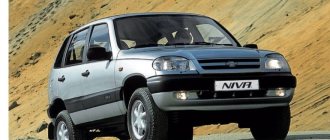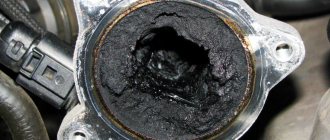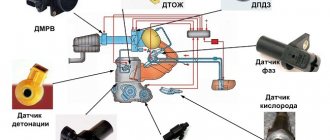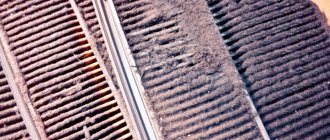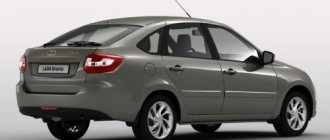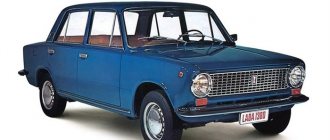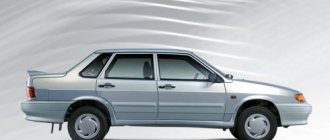Due to rising prices for gasoline and diesel fuel, today those cars that consume less fuel are in greater esteem. One of these cars is Niva. consumption on the Niva 2131 per 100 km in almost all possible configurations does not exceed 15 liters.
By modern standards, this figure may seem high, but the car is capable of driving at such a fuel consumption even over rough terrain, off-road, where most other cars use twice as much fuel as normal. The mixed fuel cycle plays an important role here.
Probably because the Niva 2131 is almost an all-terrain vehicle, it is very popular among fishermen and hunters. Of the older models, compared, for example, with the UAZ, the Niva has very good gas mileage in different conditions. You can clarify these data in the table, which shows data on fuel consumption of the VAZ 2131.
Technical functionality
The technical characteristics of the VAZ 2131 in terms of fuel consumption are as follows - the volume of fuel used is measured in several locations. There are three standard modes, which provide factory data on the fuel consumption of the machine. For the model under consideration, there are the following technical characteristics:
| Engine | Consumption (highway) | Consumption (city) | Consumption (mixed cycle) |
| 1.8 | 10 l/100 km | 15 l/100 km | 12.3 l/100 km |
| 1.7 | 9.5 l/100 km | 12.5 l/100 km | 11 l/100 km |
City mode for the Niva 2131 five-door model (engine 1800, injector) is the most energy-intensive. Although in general, fuel consumption on the Niva 2131 injector is quite acceptable for trips outside the city.
Technical characteristics of the VAZ 2131 Niva
Position: front, longitudinal Engine capacity: 1690 cm3 Engine power: 80 hp Power system: Distributed injection Turbocharging: no Cylinder arrangement: In-line Number of cylinders: 4 Number of valves per cylinder: 2 Recommended fuel: AI-95
Brake system
Front brakes: Disc Rear brakes: Drum
Steering
Power steering: no Steering type: Worm gear
Transmission
Drive: Full constant Number of gears: manual transmission - 5
Suspension
Front suspension: Coil spring Rear suspension: Coil spring
Body
Body type: station wagon Number of doors: 5 Number of seats: 5 Vehicle length: 4520 mm Vehicle width: 1680 mm Vehicle height 1880 mm Wheelbase: 2700 mm Front track: 1430 mm Rear track: 1400 mm Ground clearance (clearance): 228 mm Maximum trunk volume: 710 l Minimum trunk volume: 380 l
Basic methods
The actual fuel consumption of the Niva 2131 can be reduced due to the weight of the car.
You can get rid of unnecessary parts of the vase, which provide comfort, but take away gasoline. Driving style is an important factor influencing the engine's use of gasoline: the more extreme, harsh driving style, the more fuel will be consumed. Change your driving style to a more relaxed one, and you will pay less for gasoline in the face of rising prices.
Installing an injector is the most effective way to reduce fuel consumption, the only problem is that if the injector is already installed, the situation will not change. Gasoline consumption on a Niva leads to the data indicated above, that is, without them, the Niva will “eat up” much more fuel.
Along the highway
In addition, incorrect oil viscosity directly affects fuel consumption, so it is better to follow the recommendations for the 2106 engine: 5W-30, 10W-40, 15W-40, 5W-40 are suitable, in which the first digit indicates the lower temperature limit, and the second the upper one. In particular, if a potential buyer has free funds, then he definitely needs to take a closer look at the Lada Niva car.
What else can you win?
The more revolutions are made, the more fuel the car consumes; VAZ 2131 gasoline consumption per 100 km can be reduced if you drive at lower speeds. At the same time, on our roads low speeds can be dangerous, the best way out of this situation is to start driving smoothly and slowly reach medium speeds, and then move like that, this does not mean that you need to drive at a speed of 40 km/h - just you need to do everything in moderation.
It is better not to use an automatic transmission if you want to reduce gasoline consumption standards; mechanized control allows you to control the gasoline in the tank, so it is better to use a manual transmission.
Fuel consumption and temperature
A uniform and smooth driving style helps reduce gasoline consumption. It is not recommended to brake or accelerate the car sharply - the result will be the opposite. Some factors are present only in winter. Thanks to them, the average gasoline consumption on a VAZ 21214 can almost double.
- reduction in tire pressure, which occurs automatically due to low temperature. This entails a narrowing of the tire rubber, resulting in a drop in pressure;
- The condition of the road in winter plays a big role. If there is ice on the road, then when the car starts moving, the wheels are polished and gasoline consumption increases;
- bad weather conditions (snowfall, blizzard) force drivers to reduce their speed, which entails the same high fuel consumption.
Problems and solution
It may surprise you, but even open windows increase fuel consumption, especially in city conditions. It’s quite simple to explain: the aerodynamic properties of the car are somewhat reduced, which is why the air resistance in the Niva’s cabin increases, as a result of which the need for fuel is much greater.
The mechanics inside the cabin absorb some of the fuel from the fuel tank, for example, the air conditioner is powered directly from the Niva engine, and electrical equipment (for example, a radio) is powered by a battery connected to the engine, which also increases fuel consumption; avoid music on the road or the air conditioner , and you will pay less for fuel.
There is another simple algorithm:
- reducing the friction force in the engine will reduce fuel consumption;
- this is not difficult to do: you just need to regularly lubricate the parts with engine oil;
- the oil must be of high quality, otherwise there will be no effect;
- It is better to use high viscosity motor oil;
- increasing the pressure in Niva tires will reduce gasoline costs;
- the same laws of physics apply here: pumped by no more than 0.3 atm. tires will help reduce speed and friction with the road.
Injection 21214 “eats” more than VAZ 2121
Interior of a domestic SUV
The injector on 21214 has the following operating scheme: data on air flow, crankshaft movement, coolant temperature, engine detonation, fuel consumption, voltage in the on-board network, etc. is received from vehicle components to a number of sensors. After receiving the information, the control unit gives signals about the order of fuel supply, the operation of the ignition system, the diagnostic system, the operation of the idle air control. The injector changes injection parameters depending on the data received.
This system includes such components as sensors, a controller, the injector itself (nozzles), a fuel pump, and a pressure regulator. In it, the pump supplies fuel, the pressure regulator maintains the difference between the pressure in the injectors and the air gap in the intake manifold. And the ECU processes the information received from the sensors.
Injection engines of Niva 21214 cars, if not properly maintained, lose their efficiency, increasing fuel consumption, and often begin to stall. As a rule, the problem lies in dirty engine injectors, which cause poor mixture formation and atomization of gasoline. Cleaning the injectors can be done independently by purchasing additional materials worth about 500 rubles (including: a diamond wrench on “8”, a carburetor cleaner, a vacuum hose for the distributor, a syringe with an outlet diameter of 1 cm, an electrical cable with a toggle switch and a light bulb, rubber rings injectors, 8 pieces, O-rings for fuel pipes - 4 pieces).
At a car service center this service costs about 1,500 rubles. The injector is considered a good fuel injection system, but it is expensive, difficult to repair, requires high-quality gasoline, special diagnostic equipment and expensive repair maintenance. Therefore, many VAZ 2121 owners prefer a carburetor.
The Niva 21213 and 21214 models are more “gluttonous” than the Niva 2121. The engine on them consumes 11.5 liters in the city, 8.3 liters on the highway, and about 10.5 liters per hundred kilometers in the combined cycle according to the manufacturer’s version . In practice, for some taiga hunters, the car “eats” about 16 liters of gasoline, and in urban conditions - 13-14 liters per “hundred”.
Reinforced suspension
Engine 2130, first released in 1993, is found in the Niva 2131. Its technical parameters are as follows:
- cast iron cylinders;
- food - carburetor or injector;
- in-line type;
- four cylinders, each of which has two valves;
- cylinder diameter - 8.2 cm;
- Engine volume on model 2131 is 1.8 liters;
- power at 5200 rpm - 82 horsepower;
- torque at 3200 rpm is 139 Nm;
- engine weight 122 kg;
- oil is poured in the same volume as on the VAZ 2121 Niva;
- oil consumption from 0.7 liters per 1000 kilometers;
- service life according to the plant - 80 thousand km, according to users up to 180 thousand km
What increases gasoline consumption on Niva series cars?
Fuel consumption for the Niva 2131 is 16.5 liters in urban conditions, 12.1 liters for the mixed version and 9.7 liters for the highway. This figure can hardly be significantly reduced, and it easily increases due to improper operation of any vehicle, including:
- Overload. Not all drivers remove unnecessary items from the trunk or remove roof racks, which increases fuel consumption. You also need to take into account that car body kits, for example, a guard with protection, can weigh more than tens of kg, which also makes the design heavier.
Fuel consumption can be increased if the engine, for example, on 21214, operates outside the operating temperature. This could be a problem with the cooling system, including the thermostat, fan, cooling sensors, or coolant. It will be relatively cheap for “nivovods” to replace the thermostat, which costs about 350 rubles. The operation is performed independently, since all you need is a Phillips screwdriver.
To replace the part, you need to drain the antifreeze, then unscrew all the bolts on the pipes from the thermostat clamps, remove the pipes and remove the element from under the hood. Using a ratchet handle and a socket on “13”, you can easily change the VAZ 2121 radiator fan by unscrewing just three mounting bolts. Thus, it is possible to adjust the ventilation system without extra costs so that operating temperatures in the engine do not exceed the required 98-102 degrees Celsius.
Work and consumables can be much more expensive if the problem of increased fuel consumption is associated with poor operation of the SBU, which is based on incorrect sensor readings. In this case, problems may arise with the lambda probe, mass air flow sensor, throttle position sensors, and temperature sensors. In this case, it is better to go to the stand at the service station.
A VAZ 2121 of any series may become less economical if the car drives on bad roads, refuels at “left” gas stations, has low tire pressure or incorrect wheel alignment angles. Wide wheels, additional equipment in the form of an operating winch, the use of air conditioning, the dark color of the car, and frequent braking on forest roads can increase the amount of fuel consumed by 10-15 percent compared to that declared by the manufacturer. Therefore, each case of increased costs must be considered in relation to a specific car and driver.
The latest cars converted to gas
Since 1996, we have installed gas equipment on 40,000 cars in service centers in Moscow and St. Petersburg. See photo of the service area
| Year of issue: | 2014 |
| Body type: | SUV |
| Transmission: | mechanical |
| Drive unit: | 4WD |
| Generation: | 1st generation |
| Engine: | gasoline, 1700 cc |
| Fuel consumption on the highway: | 12.0 l/100km |
| Mileage: | 36,000 km |
| Steering wheel: | Left |
Good afternoon to you, dear forum members. I am writing to your attention, a review about one of the controversial cars of the Russian automotive industry - the Niva, or after a certain upgrade, the Lada 4X4 5D. Why is it ambiguous, because there are different myths about him in the minds of Russian people. I hope this review will help someone with choosing a car. Before Niva, I owned various cars: Toyota Vista (petrol, front-wheel drive, 1996 Sv40), Toyota Noah (diesel, 4wd, 1997), Subaru Forester (2000, 2.5 non-turbo, 4wd), high-speed Regius (2001, petrol, 4vd), surf (3.0 diesel, 4vd, 1997), Toyota East (2003, 1.5 petrol, 4vd), Subaru Legacy station wagon (2000, 2.0 not turbo, 4vd). And so, at the beginning of March 2016, having sold the Legacy, I bought a car truly for our terrible northern roads, or rather directions - a Lada 4x4 Niva (hereinafter referred to as “Jeep”). Many friends did not understand me, others were understanding, but that’s not the point. So, Jeep, the car was produced in 2014, the engine is 1.7 injector, green (according to the title it is blue-green, I don’t know how, but blue is visible only when you wash the car), 4 doors (classic all-wheel drive), 16th alloy with 205 tires /75, gray fabric interior. Car exterior. I don’t know how, but in more than 30 years, the five-door Niva hasn’t changed much. Everything is also archaic and extraordinary. The metal really shows that it has become a bit thin compared to similar cars produced in the 1990s and earlier. Mirrors with manual adjustment from the interior. An arch with fog lights was installed. The bumpers are alloy, by the way, this is the design of the bumper for a Jeep that is better than the modern Niva Urban with plastic. I installed a towbar, the functionality of the car has increased, it drags the trailer calmly. Many foreign cars do not have this device (i.e., a tow bar); on a Legacy it cost about 8,000 RUR, and on a Niva, 2,700 RUR. The difference is noticeable. Car interior. Everything is as prosaic as always, nothing superfluous. The instrument panel is simple and informative. The seats in both the front and rear are comfortable; by the way, three healthy people can fit in the back, and their knees will not rest against the back of the front seats. The plastic in the cabin is ordinary, I never understood why many people value “soft plastic and panel”, it’s easier for the owner, wipe it with a cloth and no dry cleaning or vacuum cleaner is required. The gearshift knob, there are a lot of odes and praises about it on the Internet. The truth is, it comes from the factory very short, for example, it’s very difficult for me to reach for third and fifth gear. And there are many solutions to this problem, some install a gazelle rocker, some radically remake the rocker, some simply install a longer handle. I solved the problem differently, I bought a baluster I liked, but don’t laugh, just a baluster, and using a sharpener, a saw, and a couple of drills, I made myself an individual handle, which turned out to be very convenient. About the landing, yes, the steering wheel actually looks a little to the right relative to the middle of the driver’s seat, I didn’t change anything, I just need to sit more comfortably and it will be ok. The interior lighting is not enough, I will work on it. And in the trunk, our valiant and victorious designers of the concern from Togliatti, completely forgot to install the lighting. At night, and night in winter in Yakutia begins already at 15-16 hours of the day, it is impossible to find a thing or put something neatly away. We'll have to rack our brains over this too. By the way, the size of the trunk is spacious for such a car, and if you fold the seats you can safely sleep, two people can comfortably fit in. I installed heated seats with simple pads, laid car covers on top and a Tashkent back with a fifth point. Under the hood. According to the factory tradition, the hood does not open as desired. On the contrary. It doesn’t open from the front and now you have free access, like a Chevrolet Niva, but vice versa. The engine is simple, chain. By the way, the same engineers managed to make a hydraulic chain tensioner with a thin tube from the oil sensor. In severe frosts, the roar is terrible, and your heart bleeds. It can be fixed by installing a mechanical auto-tensioner, I ordered it. I'll let you know about the results. Chassis of the car. This part of the car has not changed since time immemorial. The front suspension is on wishbones, with two balls, and at the rear there are five wishbones. At the front there is a gearbox with drives, at the rear there is an axle. I still have two universal joints on the crosspieces, I haven’t tried them on CV joints, I’ll let you know when I get my experience. The transfer case and gearbox have not changed much; there is a whine when driving. 5 speed gearbox, enough for the eyes. Power steering is a thing for this SUV. Especially in the city. Breakdowns. Fuel consumption What could we do without this? When I bought it I was very afraid that I would have to constantly repair it, but to my great happiness this did not happen. I changed the heater valve once, this is a disease of all fields, installed a luzar, I don’t know how time will tell, replaced the hub and all the breakdowns from a mileage of 27,000 (that’s exactly what I bought this car with). All. Then just change the oil, filters, spark plugs, fill up with gasoline and drive. Thank God for everything. The car makes me happy every day, it starts with half a kick. In general, from my own experience, I can say this: the car begins to crumble due to the negligence of its owner, and the quality of the spare parts leaves much to be desired. Everything is interesting about consumption. Let me emphasize that this indicator is different for everyone. Everything, as they say, depends on the gasket between the steering wheel and pedals, yes, the driver, and then the condition of the car, etc. On average, summer consumption in the city is no more than 12 liters, in winter 14-16 (depending on degrees outside, heating, oil, etc.), on the highway 9 liters.


